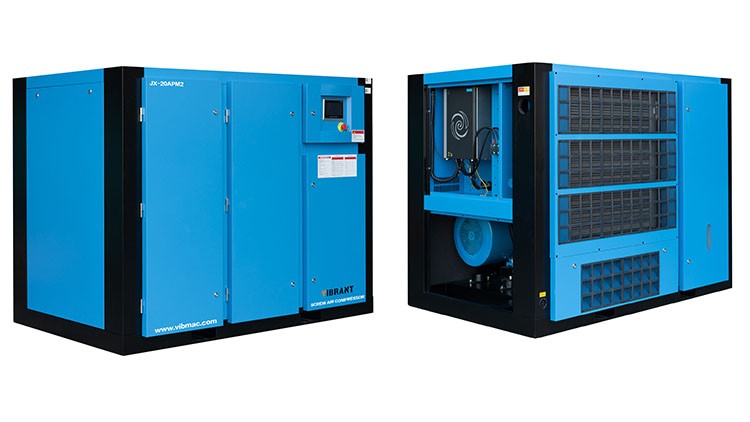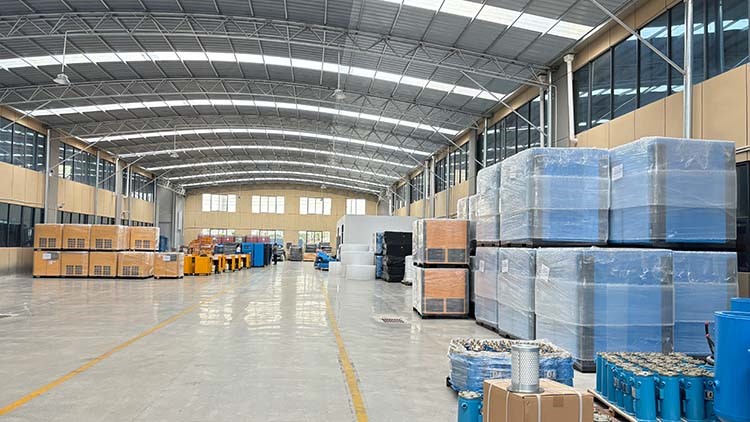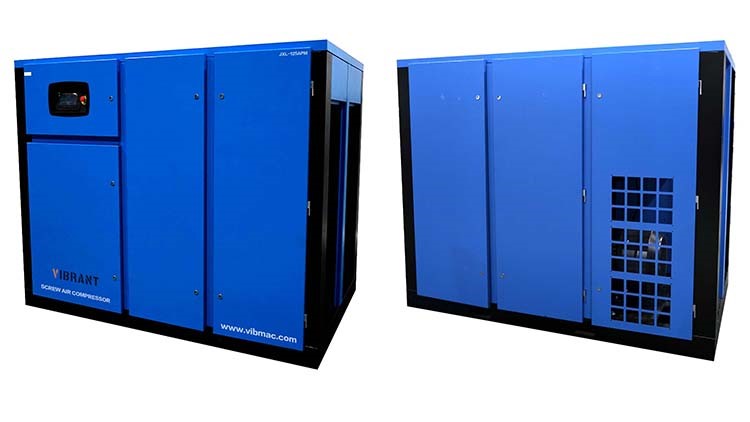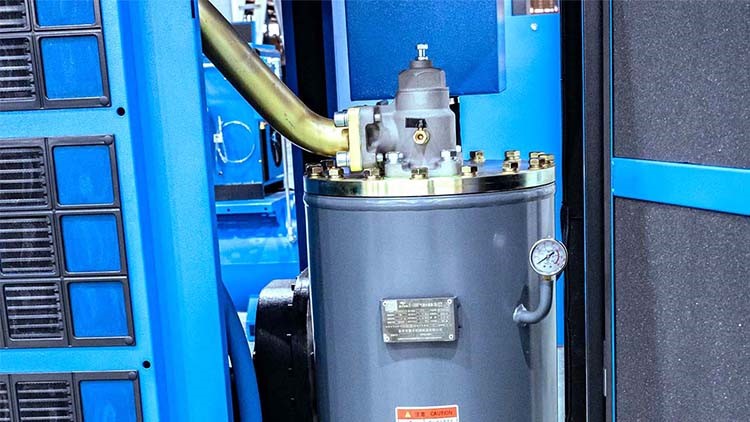A Complete Guide to Efficiency and Performance
The textile world is thirsty for power. From spinning mills to weaving looms, every step needs speed, tight control, and good automation. But what keeps all those machines humming without a hitch? In this short guide, we’ll break down the role of air compressor for textile industry, the best types to consider, why saving energy adds up, and simple tips to keep your system in top shape.
Two-Stage Air Compressor for the Textile Industry
Powerful Performance for Demanding Textile Operations
Inside many factories, the two-stage air compressor is the best for air compressor for textile industry and has earned its reputation as a tough, dependable teammate. By squeezing the air in two steps, it pushes out higher pressure while using less juice, giving steady power to air-jet looms, spinning frames, and dye tanks.
- Because textile lines often run around the clock, they need clean, stable air. Able to hold pressure up to 175 PSI, the two-stage model suits spinning mills and weaving units that never slow down. Its design also cuts moisture, a must for protecting both fabric quality and the machines themselves.
- One big perk of a two-stage air compressor is its toughness. The split-compression design puts less stress and heat on moving parts, so equipment lasts longer and needs fewer service calls.
- On top of that, it draws less power, which cuts electric bills while still feeding machines what they need. Factory floors appreciate how quietly it runs, too, keeping the atmosphere calm in sensitive spaces. Managing a heavy-load textile plant? A two-stage compressor gives you the punch and steady pressure your equipment demands.
Why Compressed Air Matters in Textile Manufacturing
Air under pressure is the lifeblood of a textile mill. Whether feeding looms, pushing dyes, or drying fabric, compressed air shows up on every floor.
– Spinning mills: pneumatic suction, air-jet yarn production
– Weaving mills: air-jet looms, shuttle-less operations
– Knitting machines: needle movement, yarn feeding
– Dyeing and finishing: automatic valves, fabric drying
– Packaging: folding, pressing, baling
Steady, clean air keeps machines lint-free and performance even. Lose that supply, and output slows while defects climb.
Picking the Right Air Compressor for Textile Plants
1. Oil-Free Compressors for Textiles
Dye houses and finishing rooms need spotless air because even a speck of oil can ruin a whole batch of fabric. Oil-free units pump 100% clean air, so your production line stays lint- and stain-free.
Best for: Printing rooms, dyeing sections, spinning floors, and any cleanroom job.
2. Rotary Screw Compressors
Rotary screw models rule most textile shops because they deliver air nonstop and keep vibration, energy costs, and wear to a minimum. Add a Variable Speed Drive (VSD) to adjust motor speed and save even more power.
3. Centrifugal Compressors
Huge mills that run around the clock swear by centrifugal machines. They move vast amounts of high-pressure air and require little upkeep, making them the go-to for centralized systems.
Best for: Major pressure needs and plant-wide, steady airflow.

Applications: Air Compressors in Action Throughout Textiles
Compressed air may be low-profile, but it runs the show in textile making. Whether spinning fibers or finishing garments, every stage counts on the right compressor to keep speed high and quality tight.
Spinning: Clean Suction and Air-Jet Support
Inside the spinning room, air compressors pull fibers, spin rotors, and feed air-jet heads. Lint-free yarn only happens when that air stays dry and steady.
Weaving: Power for Air-Jet Looms and Automation
The weaving floor leans on compressed air to run air-jet looms, dobby gears, and jacquard brains. Those machines want oil-free air at 6-8 bar, or the cloth won’t shed properly.
Knitting: Smooth Needle Movement and Yarn Tension
Knitting units use air to tip needles and hold yarn at just the right tension. Moisture in the line can snag loops and ruin the sweater’s feel.
Dyeing & Finishing: Moisture Control and Automation
Clean, dry air pushes the valve, runs robots, and wipes out leftover water. Any contamination here can stain, spot, or dull the final piece.
Garmenting: Cutting and Pressing with Precision
Air-powered presses and cutters shape and slice fabric with serious speed and little muscle.
Maintenance: Cleaning and Pneumatic Tools
Plant upkeep leans on compressors to blast dust, drive handy air tools, and keep systems running.
Why the Right Compressor Matters in a Textile Plant
1. Lint-Free Production
Choose oil-free gear so stray oil droplets don’t spoil or mark sensitive fabrics.
2. Energy Efficiency
Variable-speed drives cut power use by up to 35% during light-load stretches.
3. Consistent Quality
Steady air pressure keeps looms moving evenly, giving you smoother cloth.
4. Lower Maintenance
Work smarter, parts wear less, saving you downtime and repair bills.
5. Noise Reduction
Today’s quiet units make the shop floor easier for workers and managers alike.
Taming Moisture in Your Compressed Air
Wet air spells trouble in textiles. It can:
- Damage fabrics
- Rusty metal parts
- Slow down machines
- Beat the risk with:
- Refrigerant or desiccant dryer
- Tough filters
- Self-cleaning condensate drains
- Clean, dry air is a must for dyeing and finishing.
Easy Maintenance Habits
1. Routine Servicing
Check oil, filters, belts, and seals on schedule.
2. Spare Parts Management
Keep spare filters, belts, and valves handy to beat costly hold-ups.
3. Leak Audits
Leaks can waste 20-30% of compressed air. Scan with ultrasonic detectors.
A quick inspection today means smoother weaving tomorrow.
4. Monitor Performance
Install smart sensors to watch for pressure dips, check energy use, and record temperature swings.
Cost of Air Compressors for the Textile Industry
Prices depend on:
– Size and model chosen.
– Required pressure and CFM.
– Oil-free or oil-filled build.
– Extras like dryers, filters, or controls.
How to Choose the Best Air Compressor for Textile Production
Think about:
- What CFM and PSI/bar do you need?
- Duty cycle-continuous or short runs.
- Available floor space and layout.
- Cleanliness grade per ISO 8573-1.
- Upfront price and long-term spend.
- Ease and frequency of service.
Conclusion:
From spinning to dyeing, air compressors drive every step of textile work. Picking the right unit-whether oil-free, rotary screw, or VSD-keeps lines moving, cuts waste, and saves money. Is it time to modernize your compressed air setup? Reach out to VIBRANT now and let us match you with the ideal compressor.









